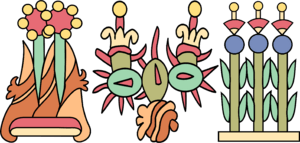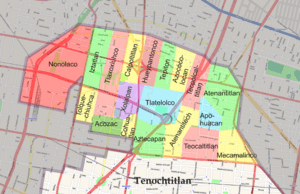Tlatelolco (altepetl) facts for kids
Quick facts for kids
Mexico-Tlatelolco
|
|
|---|---|
| 1337–1473 | |
| Common languages | Nahuatl |
| Religion | Pre-Columbian Nahua religion |
| Government | Monarchy |
| Tlatoani | |
|
• 1376–1417
|
Quaquapitzahuac |
|
• 1417–1428
|
Tlacateotl |
|
• 1428–1460
|
Quauhtlatoa |
| Historical era | Pre-Columbian |
|
• Established
|
1337 |
|
• War with Tenochtitlan
|
1473 |
Tlatelolco (pronounced tlah-teh-LOHL-koh) was an important ancient city-state in the Valley of Mexico. Its people, called the Tlatelolca, were part of the Mexica group. The Mexica were a people who spoke the Nahuatl language. They arrived in what is now central Mexico in the 1200s.
The Mexica settled on an island in Lake Texcoco. They founded the city of Mexico-Tenochtitlan on the southern part of this island. In 1337, some Mexica decided to break away from Tenochtitlan's leaders. They then founded Mexico-Tlatelolco on the northern part of the same island. Tlatelolco was very important because it had the biggest market in the area. This market was a key place for trade for both Tlatelolco and its sister city, Tenochtitlan.
Contents
The History of Tlatelolco City
In 1337, Tlatelolca declared themselves independent. This was 13 years after Tenochtitlan was founded. They chose their first independent ruler, called a tlatoani.
Early Rulers and City Growth
Under their first ruler, Quaquapitzahuac (who ruled from 1376 to 1417), the first two parts of Tlatelolco's Main Pyramid were built.
The next ruler was Tlacateotl (1417–1428). During his time, the Tlatelolca helped the Tenochca fight against the Tepanec empire. The Tepanec empire was controlled by the city of Azcapotzalco. Soon after, Tlatelolco and Tenochtitlan had their first war against each other. Also, the third part of the Main Pyramid was built during Tlacateotl's rule.
Quauhtlatoa ruled from 1428 to 1460. Under him, the Tlatelolca conquered the city-state of Ahuilizapan (which is now Orizaba, Veracruz). They also fought alongside the Tenochca against the people of Chalco. The fourth and fifth parts of the Main Pyramid were built during this period.
Tlatelolco's Final Battle
The ruler Moquihuix (1460–1473) built the sixth part of the temple. But in 1473, a big battle happened. In the Battle of Tlatelolco, Moquihuix was defeated by the Tenochca ruler, Axayacatl. After this defeat, Tlatelolco became part of Tenochtitlan. Itzquauhtzin ruled Tlatelolco during this time when it was almost fully joined with Tenochtitlan.
Observations by Spanish Explorers
Bernal Díaz del Castillo, a Spanish explorer, wrote about Tlatelolco. He thought its temple was the biggest in all of Mexico. He was amazed by the marketplace. He wrote that the Spanish "were astonished at the number of people and the quantity of merchandise that it contained." He also noted "the good order and control that was maintained." He said they had never seen anything like it before.
The Spanish Conquest and Beyond
During Cortés's attack on Tenochtitlan, the Mexica people often went back to Tlatelolco. They even managed to surprise the Spanish soldiers and their allies in an ambush. However, the entire island eventually fell to Spain.
After the Spanish conquered the Aztec Empire in 1521, they made the ruins of Mexico-Tenochtitlan their new capital. This new area was called New Spain. The native people who survived in Tenochtitlan and Tlatelolco were managed by their own leaders. These areas became towns called Santiago Tlatelolco and San Juan Tenochtitlan.
Tlatelolco remained an important place even after the conquest. This was partly because the Colegio de Santa Cruz de Tlatelolco was founded there. This was the first school for higher learning in the Americas, built for elite native men. Today, the remains of Tlatelolco are located within Mexico City.
Modern Discoveries at Tlatelolco
In recent years, archaeologists have been digging at the Tlatelolco (archaeological site). This site is now part of Mexico City. The ancient city-state's ruins are found around the Plaza de las Tres Culturas. This square has three important parts: an excavated Aztec site, a 17th-century church called Templo de Santiago, and a modern office building. In 2009, archaeologists found a large grave with 49 human bodies. This discovery was special because the bodies were arranged in a ritual way.
See also
 In Spanish: México-Tlatelolco para niños
In Spanish: México-Tlatelolco para niños




